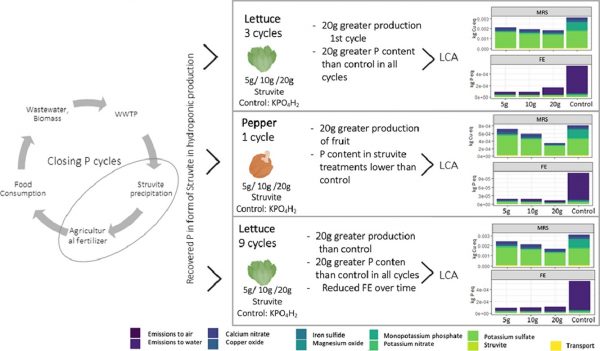Publication in Resources, Conservation & Recycling
25 January 2022See full article/ Veure l’article complet
English:
Hydroponic systems are an attractive form of urban agriculture due to their low weight load, inert substrate conditions, and overall better control of plant nutrition and growth. However, gaining urban food sovereignty cannot be at the cost of increasing environmental impacts, such as eutrophication and nonrenewable resource depletion, associated with phosphorus fertilizer use. Struvite, a wastewater byproduct, is a potential slow-releasing P source that can serve as a substitute for mineral P fertilizer. In this study, we explored the adequacy struvite in hydroponic systems, testing different quantities (5 g, 10 g and 20 g per plant) compared with monopotassium phosphate for pepper and lettuce hydroponic production. The results show competitive productions for both crops with the use of struvite, especially during the first lettuce harvest (225.5 g, 249.9 g, 272.6 g, and 250 g for 5 g, 10 g, 20 g and control, respectively) where a greater struvite dissolution was seen. Although all struvite treatments in pepper show low phosphorous content in the biomass, yields do not deviate greatly from the control (3.6 kg, 4.3 kg, 7.5 kg and 5.3 kg for 5 g, 10 g, 20 g and control, respectively). The environmental performance of all lettuce treatments showed a reduction in all impact categories, especially freshwater eutrophication and mineral resource scarcity, except for marine eutrophication. All impact categories were reduced for all pepper treatments with 10 g and 20 g of struvite. When the results are extrapolated to a full year of production, we find that the slow dissolution of struvite can sustain competitive production with an initial 20 g, with less impact in all categories except marine eutrophication
Català:
Els sistemes hidropònics són una forma atractiva d’agricultura urbana a causa de la seva baixa càrrega de pes, les condicions del substrat inert i, en general, pel millor control de la nutrició i el creixement de les plantes. No obstant això, guanyar sobirania alimentària urbana no pot ser a costa d’incrementar impactes ambientals, com l’eutrofització i l’esgotament dels recursos no renovables, associats amb l’ús de fertilitzants de fòsfor. “Struvite”, un subproducte d’aigües residuals, és una font P potencial d’alliberament lent que pot servir com a substitut de fertilitzants P minerals. En aquest estudi, vam explorar l’estructura d’adequació en sistemes hidropònics, provant diferents quantitats (5 g, 10 g i 20 g per planta) en comparació amb el fosfat “monopotassium” per a la producció hidropònica de pebrot i enciam. Els resultats mostren produccions competitives per a tots dos cultius amb l’ús de struvite, especialment durant la primera collita d’enciams (225.5 g, 249.9 g, 272.6 g i 250 g per 5 g, 10 g, 20 g i control, respectivament) on es va observar una major dissolució de struvite. Tot i que tots els tractaments de struvite en pebrots mostren un baix contingut de fòsfor en la biomassa, els rendiments no es desvien en gran mesura del control (3.6 kg, 4.3 kg, 7.5 kg i 5.3 kg per 5 g, 10 g, 20 g i control, respectivament). El rendiment ambiental de tots els tractaments d’enciam va mostrar una reducció en totes les categories d’impactes, especialment l’eutrofització d’aigua dolça i l’escassetat de recursos minerals, excepte l’eutrofització marina. Totes les categories d’impactes es van reduir per a tots els tractaments de pebrot amb 10 g i 20 g de struvite. Quan els resultats s’extrapolen a un any complet de producció, trobem que la lenta dissolució del struvite pot sostenir la producció competitiva amb una producció inicial de 20 g, amb menys impacte en totes les categories excepte l’eutrofització marina.
Figure: Graphical abstract. Methodology used and first results.

